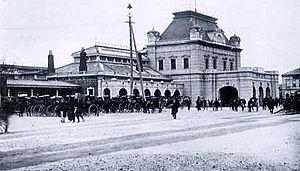Teruko Mizushima facts for kids
Teruko Mizushima (1920-1996) was a Japanese woman who did many things. She was a housewife, a writer, and an inventor. She also shared her ideas about society and worked to make things better. She is famous for creating the world's first timebank in 1973. A timebank is a system where people trade their skills and time with each other, instead of using money.
Growing Up in Japan
Teruko Mizushima was born in 1920 in Osaka, a big city in Japan. Her family ran a business. She was a good student and got a chance to study in the United States in 1939. Her trip was supposed to last three years, but it was cut short to just one year. This happened because of growing problems between the US, Japan, and China. Mizushima decided to take a quick course in sewing instead.
After she returned home, she got married. Her first daughter was born when the Pacific War began. Soon after, her husband had to join the army.
Mizushima's sewing skills became very important for her family during and after the war. People in Japan faced huge shortages of everyday items. Mizushima used her sewing skills to trade for fresh vegetables. During this time, she started thinking about how economies work and how much different types of work are worth.
In 1950, Mizushima wrote an essay for a newspaper contest. The contest was part of a national event called “Women's Ideas for the Creation of a New Life.” Her essay won a special prize from the newspaper companies. Even though the essay is now lost, the ideas in it got a lot of attention from the news.
Mizushima soon became a person who shared her thoughts on society. Her ideas were heard on the radio, in newspapers, and on television. She often appeared on NHK, which is Japan's national TV and radio station. She also traveled around the country, giving talks about her ideas.
Starting the Volunteer Labour Network
In 1973, Teruko Mizushima started her own group called the Volunteer Labour Bank. Later, it was renamed the Volunteer Labour Network (VLN). This group was a type of timebank. People could offer their time and skills to help others, and in return, they would "earn" time credits they could use to get help from other members.
By 1978, the network had grown to about 2,600 members. People of all ages joined, from teenagers to women in their seventies. Most members were housewives in their thirties and forties. The members were organized into more than 160 local groups across the country. Mizushima's home served as the main office that helped coordinate everything.
By 1983, the network had over 3,800 members in 262 groups. There was even a group in California, USA!
One important focus of the VLN was caring for older people. Before the year 2000, Japan did not have a government system to help care for the elderly. This work was mostly done by women in families, without pay. Older people who didn't have family often had very few choices for care. The VLN helped fill this important need.
While the group was not officially a women's liberation movement, it shared many goals with feminist groups. It also started around the same time many new women's groups were forming in Japan. This was when well-educated women who were not married were becoming a strong force in Japanese culture.
After Mizushima passed away in 1996, the number of VLN members slowly went down. By 2007, there were just under 1,000 members.
Books by Teruko Mizushima
- (1967) Tanoshi Seikatsu Sekkei; which means: Pleasant Life Design
- (1983) Pro no Shufu Pro no Hahaoya: Borantia Rōryoku Ginkō no 10 Nen; which means: Professional Housewife Professional Mother: 10 Years of the Volunteer Labour Bank
- (1992) Yutakasa no Seikatsu Gaku: Kyōgō Kazoku to Borantia Rōryoku Ginko; which means: Studies of an Affluent Life: Co-op Family and the Volunteer Labour Bank


